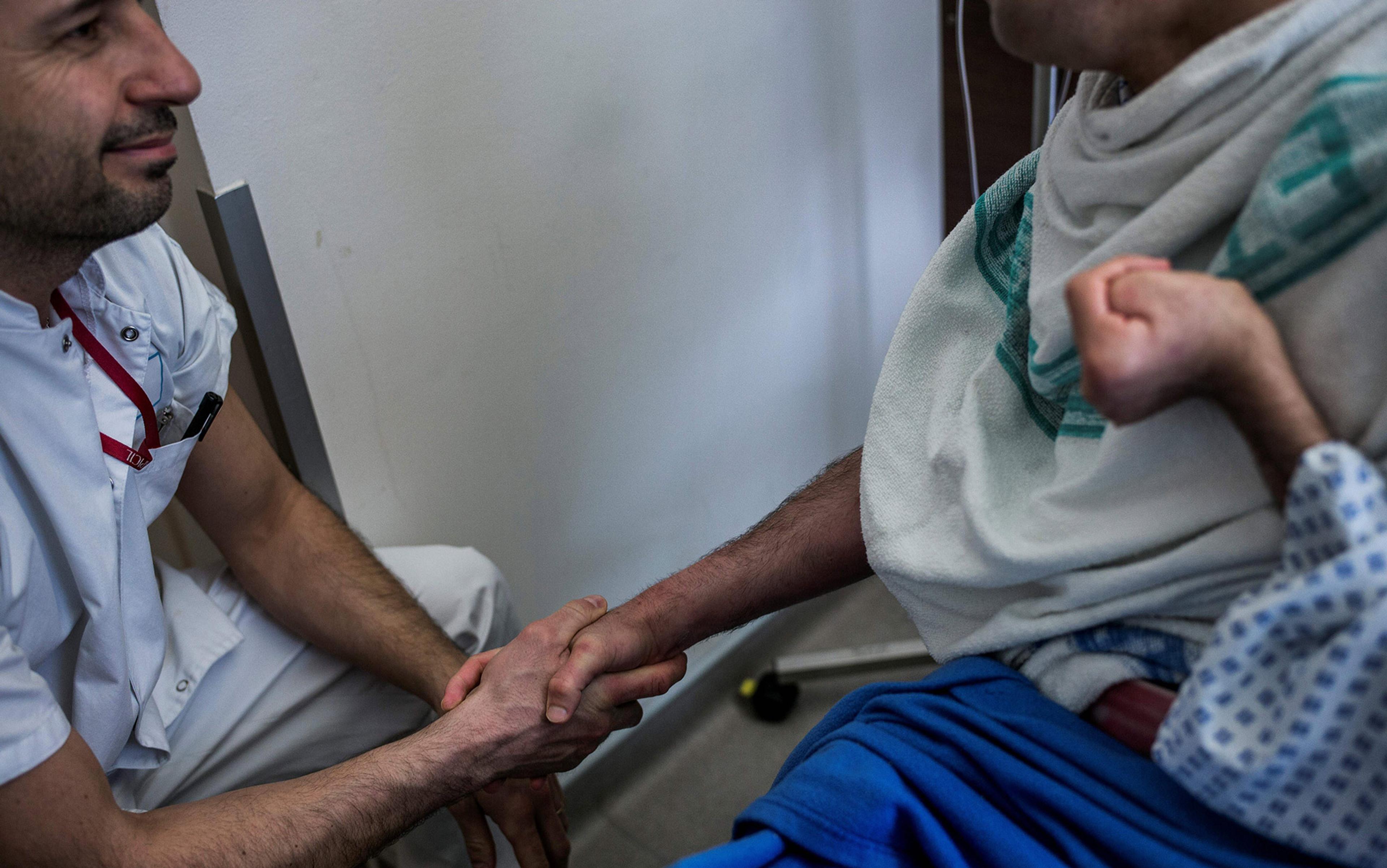One of phenomenology’s central claims is that we need to factor in the role played by embodied, perceiving, thinking and feeling agents if we want to understand the world we live in. This approach has had a profound influence on many areas of philosophy, and phenomenologists have offered incisive analyses of topics such as consciousness, embodiment, selfhood, sociality, temporality, truth, perception and action. Since its inception around the end of the 19th century, phenomenology has been seen by many as offering a new way to philosophise – one that connected with everyday experience in a way not normally found in philosophy. Early on, phenomenology started to influence empirical science and the world beyond academic philosophy. Prior to the First World War, disciplines such as psychiatry and experimental psychology took inspiration from Edmund Husserl’s ideas, and not long after, sociology and anthropology also started to engage with the work of the phenomenological philosophers. Eventually, phenomenology’s relevance for nursing science also became apparent.
Patricia Benner’s book From Novice to Expert (1984), a phenomenological study of how nurses develop embodied expertise, was a watershed. Benner’s account of nursing practice drew heavily on the American philosopher Hubert Dreyfus’s analysis of expertise and skill acquisition, which in turn was inspired by the work of the 20th-century philosophers Martin Heidegger and Maurice Merleau-Ponty. Following the success of Benner’s work, nursing researchers increasingly turned to phenomenology, and for the past 35 years journals such as Nursing Inquiry, Qualitative Health Research, Nursing Philosophy, International Journal of Nursing Studies, Nurse Researcher and Journal of Research in Nursing have published numerous articles detailing how nurses might use phenomenology as a method in their research and clinical practice.
Phenomenology has a particular interest in subjective experience, in meaning and in the lifeworld. This is an interest that phenomenologists share with nurses, who typically strive to take the experiential claims and concerns of their patients seriously. By being interested in patient experience and striving to understand people’s experiences of health, illness and care, the discipline of nursing might have more affinities with the social sciences and its qualitative methods than with medicine and its reliance on the quantitative methods of the natural sciences. Indeed, if the aim is to provide proper care for, say, stroke patients, or patients with diabetes or Alzheimer’s disease, it is important to have some understanding of what it is like, subjectively, to live with such conditions, just as it is important to understand the meaning that patients attach to the events that disrupt their lives.
This focus on patient experience isn’t simply about monitoring (and increasing) patient satisfaction. It is about obtaining information that will allow for more adequate healthcare. Some of the concerns that are part of nursing practice consequently seem to fit rather naturally with the phenomenological approach. Indeed, one reason why nursing science became interested in phenomenology was precisely because the latter was seen as a resource that could bridge the gap between research and practice. It could not only shape the way nursing research was conducted, but also inform clinical practice. It might, in short, help to ensure that the academic field of nursing research actually led to an improvement of nursing practice.
Even if there were good reasons why nurses turned to phenomenology, their engagement with that philosophical tradition hasn’t been uncomplicated. Phenomenology is a heterogeneous movement. Should one take inspiration from Husserl or Heidegger? Merleau-Ponty or Emmanuel Levinas? Alfred Schutz or Jean-Paul Sartre? Even more importantly, how deeply rooted in phenomenological philosophy must the nursing practice and research be to qualify as phenomenological? Must it, for instance, accept various theoretical core commitments found in phenomenological philosophy, or would it be sufficient for it to simply consider the first-person perspective of the patient?
Some nursing researchers have advocated a return to the classical philosophical texts, and argued that one ought to use the philosophical ideas directly in applied research. Frequently, the outcome is less than ideal. In one case, for instance, three nursing researchers at the National University of Ireland in Galway set out to show the power of the Heideggerian framework. Most of their article consists of attempts to elucidate and clarify key concepts found in Heidegger’s magnum opus Being and Time (1927), such as Dasein (German for ‘being-there’), the ontological difference, inauthenticity, solicitude, average everydayness, thrownness and fallenness. Toward that end, the authors turn to the question of application, with the experience of teenage parents as users of family healthcare services as their test case. The authors conclude that social norms associated with teenage parenthood had an impact on the lived experience of these teenagers: by no longer being carefree adolescents but young parents, they felt they were treated differently by others; some were also keen to complete their education to get financial security for themselves and their children. None of these findings are surprising. So it remains unclear why anybody needs the heavy machinery of Heideggerian philosophy to reach such conclusions.
Only a minority of nursing researchers have gone directly to the classical sources themselves. The majority have chosen a different strategy, and instead sought guidance from leading proponents of phenomenology as a qualitative research method. In recent years, the work of the education scholar Max van Manen and the psychologists Jonathan Smith and Amedeo Giorgi has been widely used and referenced by nursing researchers. Unfortunately, all three authors differ rather markedly in their methodological recommendations and in their view of how narrowly or broadly one should define what counts as phenomenological.
Smith, for instance, has argued that his own approach, which is called Interpretative Phenomenological Analysis (IPA), is phenomenological because it seeks to ‘explore the participant’s view of the world and to adopt, as far as is possible, an “insider’s perspective” of the phenomenon under study’. But is it really sufficient to consider the perspective of the informant to make the approach phenomenological?
Van Manen has deemed this to be a far too superficial use of phenomenology, and argues that Smith’s framework is ‘hopelessly misrepresentative of phenomenology in any acceptable sense’. In one of Van Manen’s recent books – meant to introduce phenomenology in a nontechnical manner to researchers who are not themselves professional philosophers – he distinguishes what he calls the heuristic, hermeneutic, experiential, methodological, eidetic, ontological, ethical, radical and originary reduction as important elements of the phenomenological method. But is it reasonable to propose that healthcare professionals should be familiar with this complicated apparatus to do phenomenological research? This is certainly not the view of Giorgi, but he too has argued that any qualitative research which is to qualify as phenomenological must employ part of Husserl’s method, in particular the epoché and reduction.
We need a balance between a too superficial and a too orthodox engagement with the philosophical ideas
In a Husserlian context, both notions are connected to very specific philosophical aims and pursuits. Their purpose is to suspend our automatic and deep-seated belief in the mind-independent existence of reality. For Husserl, it is only by not taking the world for granted that we can address a number of fundamental epistemological and metaphysical questions in a sufficiently radical and unprejudiced manner. These are important philosophical ideas. It is much less obvious that they are also ideas that everybody seeking to apply phenomenology outside of philosophy must constantly bear in mind. Indeed, is it reasonable to insist that nurses, who want to use phenomenology to provide better healthcare for patients with, say, chronic pain, or who want to draw on phenomenology to better understand the changed life-circumstances of diabetes patients, have to engage in this kind of exercise?
As I see it, nursing research’s current use of phenomenology faces three challenges: it risks being too superficial by mistakenly thinking that phenomenology is simply about paying attention to experience; it risks being too philosophical by employing too many theoretical concepts with little clinical relevance; and it risks being misled by misguided methodological requirements.
Given these risks, it is not surprising that the turn to phenomenology in nursing research has met resistance from some quarters. One persistent critic has been the philosopher John Paley who has not only accused nurses of mostly misinterpreting the philosophical ideas they claim to rely on, but who has also argued that the approaches of Smith, Van Manen and Giorgi lack methodological rigour and are permeated by personal idiosyncrasies. Paley’s recommendation has not been that nurses should turn to the primary sources and become more familiar with the philosophy on which they base their research, but rather that they should abandon attempts to ground their research on phenomenological philosophy altogether. This message has started to resonate through nursing studies to such a degree that some, such as the nursing scholar Olga Petrovskaya at the University of Alberta, have even asked: ‘Is there nursing phenomenology after Paley?’
I don’t think the turn to phenomenology was a mistake. Phenomenology contains important resources of relevance for nursing, but it is urgent to strike the right balance between a too superficial and a too orthodox engagement with its philosophical ideas. Recall why nurses were drawn to phenomenology in the first instance: to offer proper care, we need a better understanding of the complex life situation of the patient, of what it is like for them to live with the ailment in question. This is where phenomenology can make a difference. Keeping that in mind should also make it clear where the focus ought to be. The relevant question is not whether nursing research and nursing practice are using phenomenology in a manner that accords with the philosophical methods of Husserl, Heidegger or Levinas but rather whether they do so in a manner that allows for new insights or better therapeutic interventions.
To see why, it will be informative to briefly consider some of the ways in which ideas from phenomenology have found application in other scientific fields. How have other disciplines managed to translate and transfer philosophical ideas into their own nonphilosophical context? As mentioned above, one source of inspiration could be classical work in phenomenological psychiatry, psychology, sociology or anthropology. Another source of inspiration is much more recent work in cognitive science.
If we first examine some of the early applications by figures such as Karl Jaspers, David Katz, Erwin Straus, Eugène Minkowski and Schutz, what was of importance to them was Husserl’s early insistence on carefully attending to the phenomena in their full concreteness and of retaining an openminded attitude to be blinded by preconceived theories. Many of them were also interested in specific phenomenological concepts, such as intentionality, embodiment, empathy or the lifeworld. By contrast, Husserl’s more theoretical arguments for the epoché and the reduction don’t seem to have had much of an impact. It is not coincidental that Herbert Spiegelberg, in the conclusion to his impressive survey Phenomenology in Psychology and Psychiatry (1933), explicitly warns against ‘an orthodox return to Husserl’, and argues that one has to free oneself from some of the technicalities of Husserl’s philosophy if a true two-way exchange between psychology and phenomenology is to be possible.
More recently, phenomenological ideas have found their way into cognitive science, and inspired and influenced work in cognitive psychology, developmental psychology, psychiatry, and cognitive and affective neuroscience. Two examples might serve as illustration.
Phenomenologists have made substantial contributions to the study of sociality. All of them have criticised the idea that interpersonal understanding is at its core a theory-driven inferential process, and most of them have instead proposed a more embodied perceptual approach to intersubjectivity, of how we come to understand one another. These ideas have subsequently been picked up by some developmental psychologists and cognitive neuroscientists. Whereas the former have found inspiration in phenomenological texts, when it concerns the elucidation of fundamental but primitive forms of social understanding found in infants and young children, mirror-neuron theorists have emphasised the similarity between their account of embodied simulation and work done in the phenomenological tradition on empathy.
Phenomenologists have also done extensive work on the nature of consciousness and selfhood. One prominent idea gravitates around the significance of the first-person perspective, and proposes that any experience necessarily involves a what-it-is-likeness, and that experiential what-it-is-likeness is necessarily what-it-is-like-for-me-ness. The idea that experiential (phenomenal) consciousness is necessarily self-involving, that it necessarily features a minimal experiential self, has gained traction in both cognitive neuroscience and psychopathology. Central figures in classical psychiatry considered disorders of the self to play a prominent role in a variety of psychopathological phenomena. In more recent psychiatry, one can also find people who explicitly affirm their commitment to a phenomenological understanding of selfhood and who argue that schizophrenia is primarily to be understood as a disorder of the minimal self.
What is noteworthy about both examples is that, whereas the phenomenological inspiration is clear and undeniable, the psychiatrists, neuroscientists and psychologists who draw on phenomenological ideas also do so in a manner that is quite transparent. It is clear what concepts they are using and what difference those concepts are making. There is no appeal to countless technical concepts with little or no empirical relevance, nor are we seeing any insistence on the need for adhering to various specific methodological steps or procedures. The motivation for this reticence was articulated by Minkowski early on. While highlighting how a phenomenological framework could help the psychiatrist to a better understanding of some of the central experiential dimensions that are afflicted in different psychopathological conditions, and thereby allow the psychiatrist some access to the otherwise impenetrable world of the patient, Minkowski also warned in Lived Time (1970) against simply transposing the data and methods of philosophy into the realm of psychopathology. Such a direct application would in his view lead to a ‘hyperphilosophising’ of psychopathology, which risked deforming the discipline entirely.
Consider how the experience of time can change as a result of a diagnosis
Nurses interested in phenomenology should not only bear this warning in mind, but also take inspiration from the way in which ideas from phenomenology have been used and applied in disciplines such as psychology and psychiatry. A straightforward suggestion would consequently be to let nursing research and clinical practice be informed by central phenomenological analyses of topics with a direct clinical and interpersonal relevance, ie topics such as lifeworld, temporality, empathy or embodiment.
As has also been argued by Karin Dahlberg of Linnaeus University in Sweden and colleagues in their elaboration of what they call ‘reflective lifeworld research and lifeworld-led care’, if we wish to offer proper care, we shouldn’t simply focus on the symptoms in isolation. We need to understand how the illness affects the more general life-situation of the patient and how it affects the patient’s being-in-the-world, ie, his or her intentional, temporal, spatial and social sense-making. This is precisely where phenomenology can make a difference, since it offers a sophisticated conceptual framework for grasping significant features of human experience. A few examples will again suffice.
Classical distinctions in phenomenology pertain to the difference between geometric space and lived space, the time of the clock and lived time, the body as object and the body as subject. Consider how the experience of embodiment, spatiality and temporality is affected in acute or chronic illness. Consider how a person who now needs a wheelchair doesn’t simply undergo a change in embodied self-experience; if she was a dancer, say, the bodily skills that were identity-defining are no longer available – her interaction with and experience of the environment changes too. Consider how the experience of time can change as a result of a diagnosis. Consider how it might affect short- and long-term planning and change one’s experience of the openness of the future. Consider how an hour in pain, or an hour waiting for treatment, might feel much longer than an hour spent watching an exciting movie, even though the hour still consists of the same number of minutes.
The relevance of phenomenology for nursing is not restricted to these kinds of analyses, however. Phenomenology also offers insights of a more systemic nature. One interesting application of these can be found in a study from 1992 by Peter Ashworth of Sheffield Hallam University in the UK and colleagues. The idea that patients should be actively involved in healthcare decisions (rather than passive recipients) is widespread and has in particular been considered decisive for increased patient compliance. But what is the right way to involve the patient and what obstacles might arise? To address these questions, the authors turned to the phenomenological sociologist Schutz and his work in the 1950s on social interaction. They briefly presented some of his core ideas, and highlighted his discussion of the social distribution of knowledge. The authors then showed how these ideas might be used in everyday clinical practice. Participation is always contextual; it is participation in a shared cultural practice that often relies on a number of taken-for-granted assumptions.
One obvious challenge to proper patient participation is that they are encouraged and invited to participate in a medical setting involving specific tasks, procedures, aims, roles and statuses that are often unfamiliar, and where they and the healthcare professionals are not on equal footing. Whereas the nurses are trained experts who know all the standard routines of admission, history taking, ward rounds, discharge, etc, many of these procedures will be bewildering to the patients, who will attempt to make sense of them on the basis of their own past experiences. The mismatch between the nurses’ and the patients’ stocks of knowledge can easily lead to miscommunication and misunderstanding. Indeed, the very attempt by the nurses to actively involve the patients in their own healthcare decision might come as a surprise to the patients, and be interpreted as evidence of the nurses’ lack of care and concern. If the nurses are to succeed in involving the patients in genuinely patient-centred care, it is crucial that nurses recognise the patients’ varied life experiences.
It could be argued that a psychiatry (or psychology or neuroscience) that is inspired by phenomenology doesn’t yet amount to a genuinely phenomenological psychiatry (or psychology or neuroscience). Likewise, it could be argued that nursing research and practice that is inspired by phenomenology doesn’t yet amount to a genuine nursing phenomenology since it lacks the required purity and methodological rigour. The reply to this objection, however, has already been given. If nursing research is to inform and improve clinical practice, the phenomenological ideas being used must show their pertinence and be evaluated on the basis of the results (new insights or better therapeutic interventions). In that context, orthodoxy, purity and methodological rigour seem misplaced. Indeed, it is questionable whether nurses (or physiotherapists, psychologists, educators, psychiatrists, anthropologists, etc) who wish to draw on phenomenology really ought to look to it as a method – or rather than as an attitude and theoretical toolbox that can, in principle, be used in conjunction with a variety of different methods.






